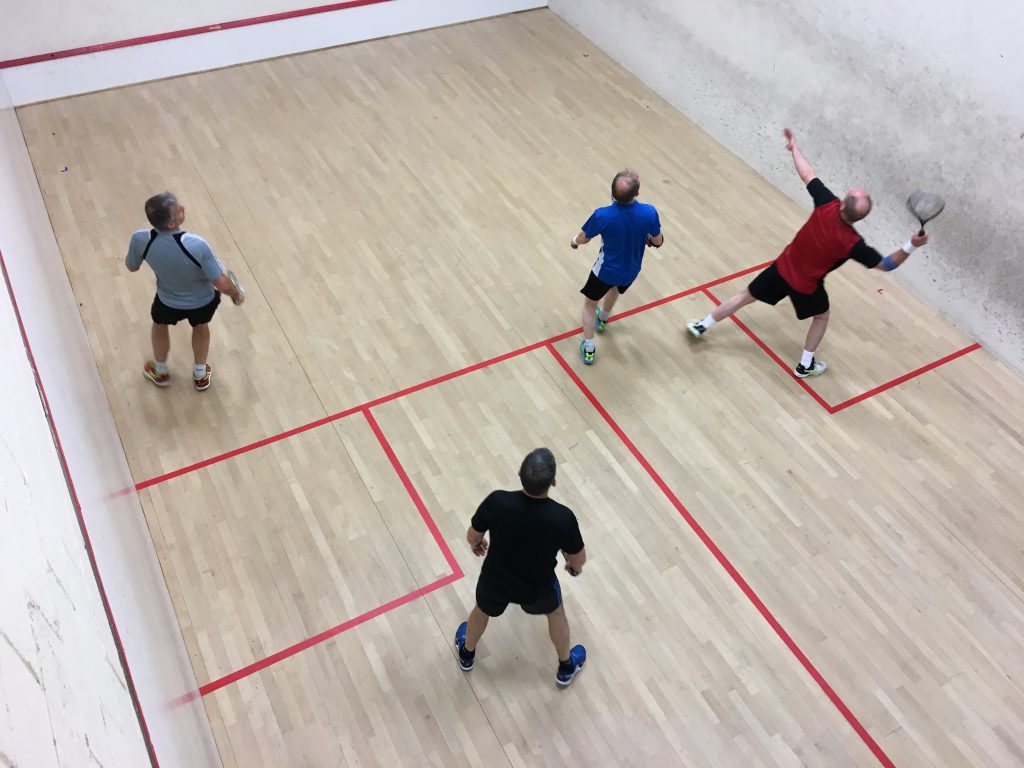Squash and racquetball are very similar sports so similar that many people have difficulty telling them apart. Squash and racquetball are both Indoor racquet sports played in box-like rooms between two competitors. In both squash and racquetball, a point is won when your opponent is unable to return a shot legally before the ball bounces a second time.

Both sports are excellent workouts that improve your foot speed hand-eye coordination and cardiovascular conditioning. While both sports are fun and challenging, what is the difference between squash and racquetball? You find there are many from the court to the equipment to the rules to the skills emphasized for success in the sports.
- The racquetball court is larger than the squash court.
- A racquetball court is 10 feet longer than a squash court while being just 1 foot narrower.
Equipment differences between Squash and Racquetball
- There is only one type of racquetball (typically blue in color) and it is very bouncy and light.
- The squash ball is smaller and comes in different colors for different levels of players the ball Is typically slower and less bouncy than a racquetball with the professionals using the slowest ball (double yellow) that has the lowest bounce for the biggest challenge in returning the ball successfully.
- The racquetball racquets handle is shorter than the squash handle and features a wider head.
- The racquetball racquet features a string “loop” at the bottom of the handle that is wrapped around the player’s wrist to prevent losing the racquet during a swing.
- The squash racket has the longer handle and longer head In order to reach balls that typically bounce much lower than a racquetball does, In case you may likely well desire to purchase a squash racquet online right here https://sportsavis.com/best-squash-racquets/.
- Eye goggles are mandatory in competitive racquetball for safety reasons due to the speed of the shots.
Playing differences between Squash and Racquetball
- There is no out of bounds in racquetball aside from shots that go into the viewing area in the upper back area of the court.
- In squash, the ball must stay below the 15-foot red line on the front wall and below the 7 foot red fine on the back wall.
- All serve in squash must also hit above the 3-foot service line to be legal.
Scoring differences between Squash and Racquetball
- In squash, you can score points on both your serve and your opponents serve while in racquetball you only score on your serve.
- In squash, games are played the first to 11 points or “PAR” If players are tied at 10 the game continues until one player is ahead by two points.
- In racquetball, games are won by reaching 15 points first and there is no need to be ahead by two points.
- Squash is played in a best of 5 games while racquetball is played in a best of 3 formats.
Also Read: Difference Between Pool & Snooker
Some of the biggest differences between squash and racquetball are much more subjective than technical. Due to the ball being bouncier and lighter and there being fewer out of bounds scenarios racquetball rewards powerful shots.
In racquetball, a successful winning shot is often a powerful low shot that gets past your opponent before they can react. In squash, the ball is much less bouncy and finesse “drop” shots that barely hit the front wall are very effective.
In squash, it’s much more difficult to get to the ball before it bounces twice and it also cannot be hit as fast as a racquetball. This makes squash more of a slower game that requires more finesse and arguably more strategy, than racquetball.
In squash, It Is much more common to try, to set up your opponent with one shot in order to place your next shot into a location that they be unable to reach. In racquetball, shots like a “drop” shot would rarely work because the ball bounces higher and would leave your opponent closer to the wall and in great position for a very powerful shot that would be difficult for you to return.
While squash advocates would argue that the slower ball makes more strategy in their sport racquetball advocates would argue that you have to that their sport requires just as much strategy and you have to think faster clue to the pace of play.
Whichever sport you prefer both racquetball and squash are great ways to compete while getting in a cardio workout that will far surpass your usual jog on the treadmill or cardio circuit.